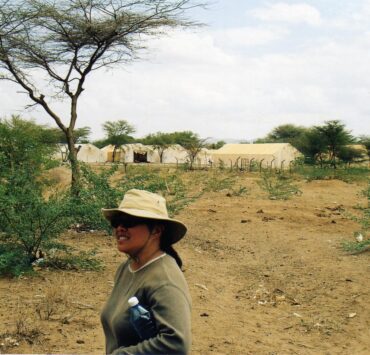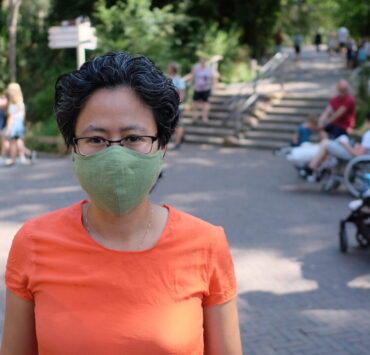Filipino artists in the Europe art scene

As an artist, it is so much more special for Joel Vega when say, a 10-year-old child appreciates and connects with his work.
“It is something magical, worth more than a thousand compliments or people buying it,” he tells this writer as we sip coffee in his living room decorated with works by Filipino artists.
Vega has been creating contemporary artworks since moving to the Netherlands in 1999 to join his partner. It took a decade for this Filipino expat based in Nijmegen to build his collection using different techniques such as assemblage, collage, photo-transfer and embroidery. He used to be a journalist and was involved in literary arts in the Philippines before migrating to Europe.
He started mounting exhibitions in 2010, getting noticed almost immediately. In fact, Vega has been winning awards at the De Gelderlander Art Prize, an art competition in the Netherlands for non-professional artists, for three years already. Twice he won the top plum and once as a runner up.
Like Vega, a lot of Filipino artists living in Europe are now being recognized albeit slowly. In March this year, the Philippine Embassy in Rome presented a few of Vega’s peers with an award recognizing their contribution in elevating the Filipino identity and artistry in their adopted countries through their artworks. Among the awardees was painter Leon Pacunayen, the first Filipino in recent decades who made a significant presence in the Italian art circle.

STARTING OUT
Many will agree that Europe’s charm and beauty can indeed be the perfect incubator, if not catalyst, for an artist’s passion. Being here simply inspires one to be a poet, a sculptor, or a painter. Some rekindles their love to create. Bong Delfin at his atelier in Odense, Denmark
Former industrial engineer Bong Delfin, for instance, did not imagine that he would be painting again when he moved to Denmark to work as an au pair. After attending an art festival in Kertminde, a picturesque town in Denmark where his host family lives, he was inspired to paint and draw again. Those were his old hobbies that started when he was still very much into comics. Delfin’s employer recognized his talent and encouraged him to pursue his art.
Last year, Delfin joined the Kertminde Art Festival, the same event that rekindled in him the love for painting. He won the Artist of the Year award, a recognition that changed his life.
“The award led me to a life changing decision of pursuing an art career here in Europe. It was really a big break for me. But I consider it only as the first step to finally pursue my passion,” says Delfin.

Similarly, for young photographer Sheryl dela Cuesta, being an artist used to be just a mere dream especially for a nursing student who had only enough money to support her schooling. In 2002, she was petitioned by her parents to come to Italy. Once there, she devoted most of her time working until the day came when she was finally able to buy a DSLR camera. Sheryl dela Cuesta’s award-winning photo of a pregnant woman
Sheryl dela Cuesta’s award-winning photo of a pregnant woman
“I met friends who were into photography, too. So we started to do photo walks, read about photography related articles online, and joined groups on social networks like Flickr and Facebook. It wasn’t easy. Sometimes it was really frustrating not to achieve the photos I wanted. But if you love what you’re doing, you would find ways to overcome it,” says dela Cuesta, who is also known as Bushe in the Filipino community in Italy.
This year, Dela Cuesta became the only Filipina whose work was included in “La Mente Artistica – Giovani Donne Artiste a Confronto” or “The Artistic Mind – Young Women Artists in Comparison.” Her featured piece was a heart-warming silhouette of a woman in her late trimester, tenderly holding her belly.

NO GUARANTEES
According to Vega, mounting an exhibition is just fifty percent of being an artist. Hard work plus the challenges of creating your masterpieces make up the other half of the equation, but it still won’t guarantee success. And living in a continent where some of the world’s great masterpieces were created can be difficult for artists with no formal training and with a completely different cultural background to break into the scene.
Here, the bar is set high. Talent only plays a small part in your success as an artist. Discipline combined with hard work and passion may get you there but it offers no guarantees, says Vega.
The artist’s ethnicity can put them in a box, too. Art lovers in a particular country will most likely find a connection with artworks that can relate to their cultural and historical backgrounds. Some curators judge the artist by the school they went to. This can be a tough wall to break for Filipino artists.
“It’s a natural instinct for everyone to put people in boxes because it is easier that way and curators know this as well. They follow a certain theme, a sort of narrative line that connects artists in a particular exhibition otherwise it would be a big circus and that’s not the point. If you don’t fall into these boxes, you may fall into the cracks,” says Vega.
He adds,” “The art world is like a jungle. People are not nice, they can be very nasty. So you have to be prepared for that.”
In the case of Delfin, holding on to his cultural influences from the Philippines while being inspired by European artists like Gustav Klimnt has become difficult for him to find his identity and style. His early works, Delfin says, were heavily influenced by Klimt. He eventually got inspired by different artists he read and studied along the way.
“Being self-taught plus my exposure to both the cultures of the Philippines and Denmark makes me confused about my art style sometimes. But I think eventually, I can find my own direction and evolve more,” he confesses.
To find his own identity and further improve his techniques, Delfin enrolled himself in an art course at the Odense Fagskole.
All things considered, Vega says, Filipino artists will soon discover that enthusiasts as well as collectors are more attracted to pieces that show an artist’s authenticity.
“In art, authenticity is very important. You are a product of your own culture, of your own history. You can’t fake your history. Maybe you can but how long would you be able to sustain it? One way or the other, people will see it.”
Good art, he says, all boils down to exploring the depths of human existence.
“Good art always addresses the core themes of humanity. I agree that the best art should be universal. The surface appearance may carry some local meaning or implication but the core of any artwork always speaks to humanity and that is the same across cultures. If you are an artist and you address that subject matter, your art will succeed [especially] if it is well presented,” finishes Vega.
This article was first published in The Filipino Expat Magazine, Issue 07, 2014.
What's Your Reaction?
Dheza Aguilar is the Managing Editor of The Filipino Expat Magazine. She was a former Netherlands correspondent for ABS-CBN, and freelance writer for other publications. She works for a supply company in Rotterdam and is eternally juggling passion and career.



